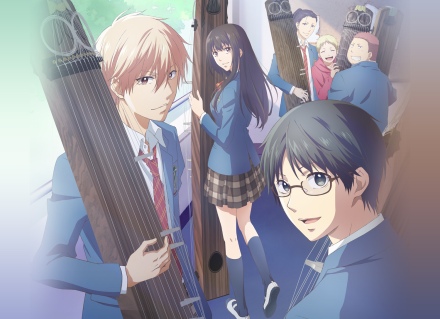A brief spoiler-free review of the 13-episode spring 2019 anime “Kono Oto Tomare!” or “Sounds of Life,” animated by Platinum Vision, directed by Mizuno Ryouma, and based on Amyuu Sakura’s manga of the same name.

An Unexpected New Member
Underclassman Takezou Kurata had a blast last year playing the koto, a traditional Japanese string instrument, with the rest of his club mates. But now that his seniors have since graduated, Takezou will have to seek out new members to join the koto club, or else risk disbandment. Prepared for the worst, Takezou gives in to his club’s fate, when out of the blue a new member barges through the club room door. This would be a great turn of events for Takezou, if only this new member, Chika Kudou, weren’t one of his school’s most notorious bullies!
Things get even more wild for this music nerd introvert when Satowa Houzuki, a well-renowned koto player in her own right, decides to join Takezou’s shabby club. What might a pro like Satowa be doing lurking around his little club? And what could a thug like Chika want with something as culturally feminine and delicate as the koto?
As Takezou simultaneously struggles to keep his club alive and maintain the balance between these two wild souls, he slowly starts to realize that the first step to gaining his own sense of self-confidence is by making friends with people from all walks of life.

Trying to Fit Together
Kono Oto Tomare!: Sounds of Life is a school music drama series with the spirit of a shounen anime and a dash of budding romance. In many ways, it is also an underdog tale, as we root for Takezou’s dysfunctional club members’ various attempts to perform together. This especially becomes apparent when Chika’s three friends also join the club, determined to play with Chika despite not even knowing what a koto is.
In one corner we’ve got an easily frustrated Satowa trying her hardest to dumb down her wealth of knowledge and teach, and in the other we’ve got these three idiots. To top it all off, Chika’s fiery attitude makes him a pain in the rear to work with, and President Kurata doesn’t know what to do about him. It’s no wonder the club’s barely getting by!
At first, the series is about trying to mash these these conflicting personalities together to even play a single piece from beginning to end, while the last few episodes give us a preview into the world of formal competition and school rivalries. The narrative of Kono Oto Tomare! is tightly written, yet it is able to juggle all these character perspectives quite splendidly. From the talented to the talentless, we see that playing the koto isn’t even a matter of being gifted, but rather of hard work and dedication to the art. The same goes for performing as a group. You can’t just play together—you have to understand one another if you are to properly read the other’s cues, direction, and cadence.
And that’s something I thought the series did really well. We are given well-timed character backgrounds to explain these seemingly irrational behaviors, as well as motives for why they joined the club in the first place. Chika and his friends play because they owe someone else their sound; Satowa plays because she wants to make a name for herself. Even if some of these backstories come off as a bit too melodramatic (like, it feels as if y’all tear up about everything), the story is never lacking in heart.
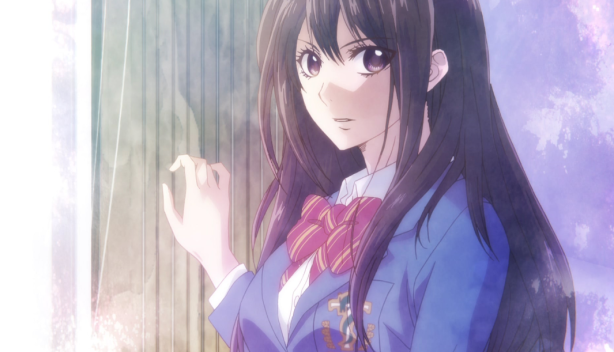
The Club’s Key Players
As a character, Takezou still has a long way to go, but certainly progresses quite a ways from his shy inward self to someone who is willing to give orders (as a good club president should). He often undermines his own musical abilities, despite having played for so long and with so many other great players. Humble, perhaps, but insecure? Definitely. The more he plays with Chika and Satowa, however, the more he is forced out of his comfort zone. And for him, that could be a good thing . . .
For Chika, this is a tale of redemption. To atone for the actions of his past, he takes up the koto with not much else than his determination and the koto his dad left behind for him. Arguably, Chika is the lead in this story, as so many of the interactions between characters are often between him and someone else. Despite his charming looks, his nasty reputation comes from his delinquent attitude and history as a rascal. This earned him few to call a true friend, but the ones he has now really are all he need.
Though she may not seem like it, Satowa is also a character wrapped in layers of insecurity and burdened by childhood scars. The prestige and honor that comes with being a member of the Houzuki school—in addition to being the family’s only daughter—led to a life of social pressures and unreasonably high expectations. Wanting nothing more than to leave that life behind and pursue music through her own virtue, Satowa takes this new life as a second chance carve a name for herself. Naturally, the chemistry between someone as talented as Satowa and a “thug” as lowly as Chika is entertaining. But perhaps their meeting is also the beginning of a loving, supportive relationship. Only time will tell.
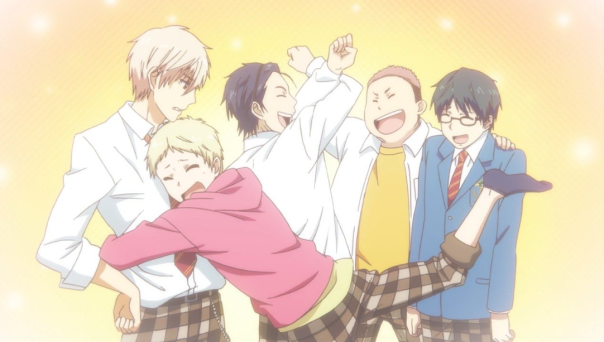
In addition to balancing these three leads, the series also features a great cast of supporting characters that are so well-defined on their own that they might as well be leads of this story, too. I’m talking about the scheming and manipulative Hiro Kurusu who practically does a 180 to become one of the series’ most heartwarming characters (and another lady to keep Satowa company). On the con side, there’s Takanami, the club’s really irritating, piece a shit advisor. He may be a necessary evil to draw out Takezou’s confidence, but I’m sure the plot could’ve done that by other means.
And we can’t forget about Chika’s three bumbling friends! They may be idiots, but they’re not just there for comic relief. Kouta, Saneyasu, and Michitaka are honest voices for those unfamiliar with the music world, actively admitting that their fingers hurt when they play too much, that an instrument can be hella expensive, and that standing behind the curtain to go on stage might as well be like walking to one’s own doom.
A show committed to togetherness, friendship, and unity, I really like how the story never forgets about these three goons. While the pros mask their insecurities with their talent, they can tell us exactly what the koto experience feels like. As a character driven piece, it wouldn’t be the same with even just one of these key players missing.
Funimation produces an all-around exceptional dub for this high quality series. English voice actor Alejandro Saab’s Takezou is played with a higher, shakier register, and doubles nicely against Chika’s barreling, rough-and-tough voice. Damon Mills steals the spotlight as Chika, as he not only has the thug voice down pat, but also makes your cheeks blush with his tender tsundere character. Amber Lee Connors follows with an amazingly strong performance as Satowa, and it’s always fun having Josh Grelle (Kouta) and Austin Tindle (Saneyasu) around to make us laugh.

Visuals to Match the Sounds
A good series about music needs good music to back it up, and Kei Haneoka’s soundtrack blends the traditional beauty of the koto with piano rifts and modern pop sounds. The OST especially works well with some of the series’ more intense moments, but is also pleasantly there to lift everyone to their feet when the comedic scenes hit. All of the koto playing itself sounds professional, almost too good for mere high school students (and beginners at that), but it’s never enough to stick out as “impossible.”
I’m just glad that we got to hear so many solos and uncut playthroughs of, what I’d imagine to be, classical pieces for this ancient instrument. Piercing melodies, spiraling duets, precise rhythms, raw tones—it’s all there, and as a string player myself, I found it all to be incredible.

As if this series couldn’t get any better, I’m thrilled to report that Kono Oto Tomare! is lovingly supported by bright, watercolor art and gorgeously fluid animation to match the timeless sounds of the koto. Character designs are reminiscent of this soft, glowing shoujo style: sparkling eyes, blushing cheeks, sunburst filters, the works. The koto itself is laden with pretty wood patterns and textures, complete with shiny metal pegs and gleaming strings. Really, I was floored by it all. What a gem of a show!
Special shoutout to Shouta Aoi’s cheery and uplifting OP theme, “Tone,” which features artistic imagery, vibrant pink and blue hues, and of course, well-timed visuals to Aoi’s wholesome voice.
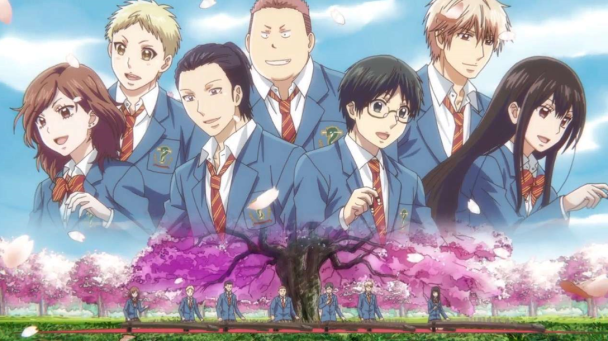
Practice Like You Perform
In case you couldn’t tell, I really resonated with this series. At long last, we have a music anime with animation that can actually keep up with the technicality required to play string instruments. While I could have gone for even more full, uncensored music scenes, I’m totally happy with the few all-out performances we got. Every time they strike the final chord, you just want to wave your fist triumphantly in the air like, “YEAH, they did it!!”
If I were to describe this series with one word, it’d be competent. Truly, we are blessed to get a string music anime that not only looks this great, but sounds good, too, and has a story that can more than carry itself. With a second season set to air this fall, Kono Oto Tomare! has proven itself worthy of the koto and its timeless beauty. This only goes to show that, when you practice like you perform, you’ll get the results you expect. In the case of this great music anime that perfectly balances comedy and drama, season two is the encore that Takezou, Chika, Satowa, and the others in this persevering koto club deserve!
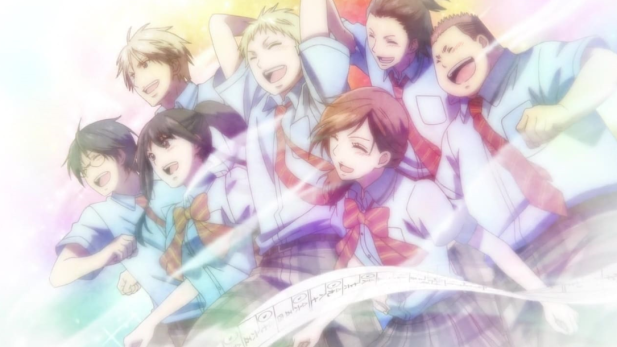
The stage is a reward for all the hard work you’ve put in. That’s why you have to enjoy it as much as you can. — Takezou Kurata
Afterword
As it stands, Kono Oto Tomare!: Sounds of Life is a “Cake” title set for the “Cafe Mocha” gold so long as the sequel is able to pick up everything this amazing first season has done so far and run with it. Given the fact that Platinum Vision has only produced a couple anime in the past and that this is Mizuno Ryouma’s directorial debut, I’m not only impressed but surprised at the quality of this work. To music fans, drama fans, or even lovers of comedy, I honestly can’t recommend this show enough!
Who else followed Kono Oto Tomare! this past spring 2019 season? I’d love to hear your thoughts on the series or this review down in the comments, as well as whether you are interested in starting it if you haven’t yet done so. Until the next time, this has been
– Takuto, your host

